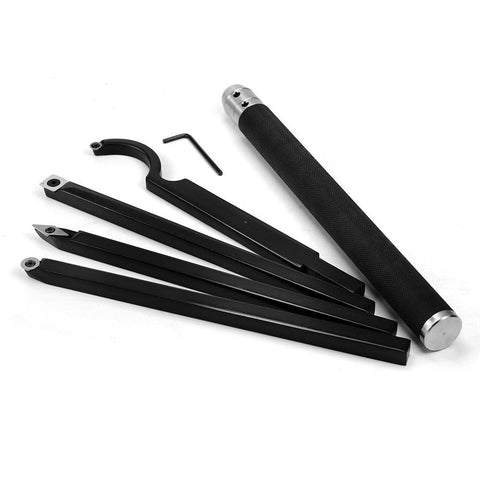Precision Engineering: The Advantages of Carbide Insert Lathe Tools
Carbide insert lathe tools have transformed the landscape of machining, providing unparalleled performance and efficiency for a variety of applications. These tools, characterized by their replaceable carbide inserts, offer a unique blend of durability, precision, and versatility that appeals to both professional machinists and hobbyists alike. Understanding the benefits and capabilities of carbide insert lathe tools can enhance your machining processes, making your work more efficient and effective.
One of the primary advantages of carbide insert lathe tools is their exceptional hardness and wear resistance. Carbide, composed of tungsten and carbon, is significantly harder than traditional high-speed steel (HSS) tools. This hardness allows carbide inserts to maintain sharp cutting edges for a much longer duration, reducing the frequency of tool changes and sharpening. In high-volume production environments, this longevity translates to significant cost savings, as operators can focus on machining rather than maintenance.
The ability to withstand high temperatures is another key feature of carbide insert lathe tools. During machining, friction generates heat, which can quickly dull HSS tools. Carbide inserts, however, excel in high-temperature situations, retaining their hardness and cutting efficiency even under extreme conditions. This thermal stability makes them ideal for machining tougher materials, such as hardened steels and other alloys, ensuring consistent performance and high-quality finishes.
Carbide insert lathe tools also offer remarkable versatility. They are available in a wide range of geometries and configurations tailored for specific applications, including turning, facing, threading, and grooving. This diversity allows machinists to select the appropriate insert for their particular task, enhancing the effectiveness and precision of their work. The ability to switch inserts rather than entire tools not only reduces downtime but also allows for easy customization to meet the specific needs of a project.
The design of carbide insert lathe tools contributes to their efficiency in chip management. The geometry of the inserts can significantly affect chip flow and removal, which are critical factors in achieving smooth cuts and preventing tool damage. Effective chip management reduces the risk of tool wear and breakage, ensuring longer tool life and better surface finishes. Many carbide inserts are specifically designed to enhance chip evacuation, further improving machining efficiency and maintaining the integrity of the workpiece.
Another notable benefit of carbide insert lathe tools is their ease of use. The ability to replace a worn insert quickly simplifies the tool maintenance process, making it accessible even for those who may not have extensive machining experience. This user-friendly approach is particularly appealing to beginners, who may feel intimidated by the complexities of tool maintenance. By allowing quick changes, carbide insert tools foster a more efficient workflow, enabling users to achieve better results without extensive downtime.
While carbide insert lathe tools offer numerous advantages, they are not without their challenges. The initial investment in carbide inserts and the necessary tool holders can be higher than traditional HSS tools. However, this upfront cost is often offset by the long-term benefits of reduced maintenance and increased productivity. For businesses that rely on consistent output and high-quality finishes, the return on investment for carbide tools can be substantial.
Brittleness is another consideration when using carbide inserts. While carbide's hardness is an asset, it also makes the material more susceptible to chipping or breaking under excessive forces. Machinists must exercise caution and employ proper techniques to avoid damaging the inserts. Understanding the limits of the material and selecting the appropriate cutting parameters are essential to maximizing the lifespan of carbide inserts.
Maintenance of carbide insert lathe tools is generally straightforward, but it does require some knowledge. While inserts may not need frequent sharpening, it is crucial to inspect them regularly for wear or damage. A worn insert can negatively affect machining performance and surface finish, so timely replacement is essential. Many manufacturers provide guidelines on the best practices for maintaining and changing inserts, which can help extend tool life and ensure optimal performance.
The introduction of advanced technology has also enhanced the effectiveness of carbide insert lathe tools. Innovations in insert coatings, such as titanium nitride (TiN) or aluminum oxide (Al2O3), have improved wear resistance and reduced friction. These coatings help protect the inserts from heat and wear, allowing for even longer tool life and improved performance in demanding machining environments. The combination of high-quality carbide materials and cutting-edge coatings results in tools that can handle a wide variety of machining challenges.
In the realm of woodturning, carbide insert tools have also gained popularity due to their efficiency and ease of use. Woodturners appreciate the smooth finishes and precision these tools offer, making them ideal for creating intricate designs and detailed work. The versatility of carbide inserts allows woodturners to switch between various applications seamlessly, enhancing their creative possibilities.
Ultimately, carbide insert lathe tools represent a significant advancement in machining technology. Their hardness, thermal stability, and versatility make them an invaluable asset in a variety of applications. While the initial investment may be higher than traditional tools, the long-term benefits in terms of efficiency, precision, and cost-effectiveness often outweigh the drawbacks. By embracing carbide insert tools, machinists and woodturners alike can elevate their craft, achieve remarkable results, and enjoy a more productive experience in their workshops. As the field of machining continues to evolve, carbide insert lathe tools will undoubtedly remain at the forefront, driving innovation and excellence in the industry.



